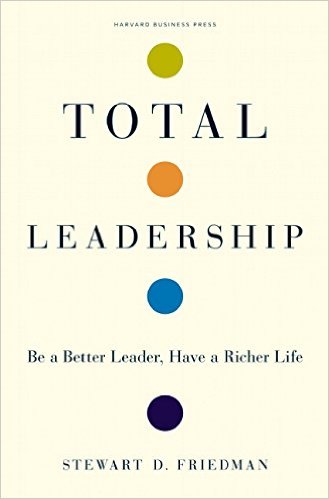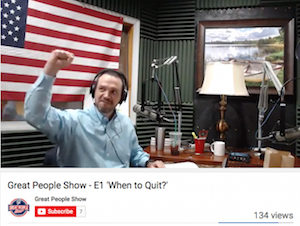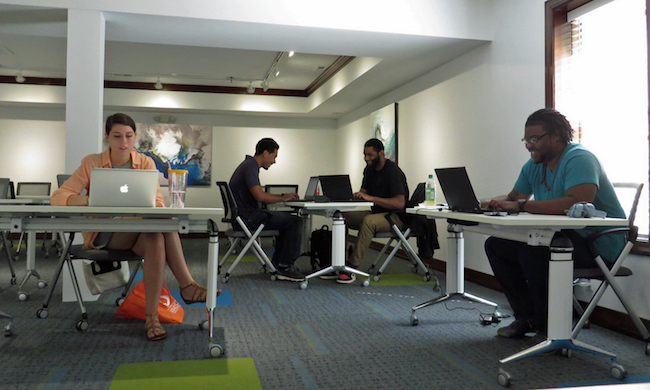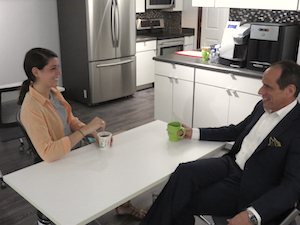Follow the Leaders
Five Simple Video Content Marketing Tips for SMB Owners
Are you using video content to engage your audiences on social media? As we reported in “Video Marketing on a Small Budget” post, video content is expected to be the driving factor behind 85% of search traffic in the U.S. by 2019.
“Understand that one video is not going to change the world,” says and Glenn Lock, VACEOs sponsor and owner of TachLock Video Services. His advice is to create a video library. “I suggest you create more than one video about different aspects of your business. Having content that people can explore is better as it increases your SEO and it’s going to maximize your presence in keyword searches.”
Your library might include demonstrations on how a product is made, a location or facility tour, or an introduction to your employees or customers, for example. Or it could be a chance to highlight your involvement in community or charitable event.
Whichever type of video you choose to shoot, don’t forget to optimize your content for search engine and social media marketing. Here’s are FIVE simple tricks that can elevate the impact of your video content.
Is your business video library full of interesting content? What advice do you have for SMB CEOs?
Five Ways to Use Ensure Your Video is Optimized for Social Media Marketing*
#1: Focus On One Message
Probably the most important tip to remember. Keep your video content simple and concise. Videos that focus on only ONE point or message perform the best.
#2: Take Note of the Sound Quality
Sounds obvious, but bad sound quality is a social media audience turn off. Make sure you’ve chosen a good location to shoot your video to ensure there is as little background noise as possible. Do a sound check before you say, “Action!”
#3: Optimize Search By Adding Keywords, etc.
You’ve made a great video, but before you begin to market it, make sure you’ve added carefully crafted descriptions, keywords, key phrases and/or hashtags so the social media platforms can find it.
#4: Optimize for Autoplay
Some social platforms offer Autoplay so your video is automatically playing as the user passes over it. Bonus tip: Make sure you have movement in the first few frames to grab attention quickly. (Use this feature sparingly, as it can increase data charges for mobile users.)
#5: Add Subtitles
This allows you to reach the hearing-impaired AND users who are unable to turn the volume up or locate their headphones at the moment. Bonus tip: Consider ways to repurpose this written content into an article!
*source: http://www.socialmediaexaminer.com/26-ways-to-use-video-for-your-social-media-marketing/
Work-Life Balance for CEOs
 Council member George Forsythe called me last fall. He told me that like most CEOs, he has struggled with work-life balance, trying to fit it everything in, and reacting to everyone else’s needs. He told me how he had found Stew Friedman’s Total Leadership and he started changing his life. George shared that he now enjoys better health, better relationships with family and co-workers, and increased community involvement. George said, “I feel much more in control of how I choose to spend my time.”
Council member George Forsythe called me last fall. He told me that like most CEOs, he has struggled with work-life balance, trying to fit it everything in, and reacting to everyone else’s needs. He told me how he had found Stew Friedman’s Total Leadership and he started changing his life. George shared that he now enjoys better health, better relationships with family and co-workers, and increased community involvement. George said, “I feel much more in control of how I choose to spend my time.”
I happen to know 200 more CEOs who face the same challenges! I got off the phone with George and called Stew. I learned that he did not develop his work in some ivory tower, but in the trenches at Ford Motor Company. Stew now teaches Total Leadership to business students at the Wharton School, where his course is perennially ranked a favorite. And, he takes his life changing work to major corporations all over the globe.
We convinced Stew to offer a one-day workshop for us in Richmond on October 13. We are opening up this workshop to area CEOs and their executive teams. I hope that you will take the time to change your life for the better. You can learn more and sign up here.
Video Marketing on a Small Budget? Hear from Our Experts
Did you know that using the word “video” in an email subject line boosts open rates by 19 percent? And click-through rates by 65 percent?* Video content will be the driving factor behind 85 percent of search traffic in the U.S. by 2019, according to AMA.org. According to the AMA, “Whether it’s Snapchat, Instagram or Facebook, video content on social media is what marketers need to focus on in 2017.” The word is out, and many CEOs of small and mid-sized businesses have already taken note.
On Trend: Video
“The introduction of social media has made it very clear that video has a more substantial place in the marketing efforts of smaller companies,” says Glenn Lock, Owner of TachLock Video Services.
“Business owners are now aware of the power of the video,” says Lock, who is also a VACEOs sponsor. “They understand that if you have a video on your website, it gets clicked on very, very quickly and there’s a higher level of engagement with your audience. There’s also a better understanding that a video done with character and energy using a cellphone can be very valuable. Smaller companies recognize that making videos is no longer cost prohibitive, and it’s also not technically prohibitive.”
CEOs are now investing time and resources outside of traditional testimonial content. Product demos, educational videos, brand spots, niche marketing videos and even company success stories are emerging. (View video: ACORN Sales Company Success Story.)
Charlie Connell, Principal, Punch Advertising, says, “At Punch, we utilize video for everything from training our clients how to use the tools we build for them to telling their stories and launching new products we develop for them.” The VACEOs member explains, “We’re generally engaged to help our clients create brands, support existing ones, build awareness about a new product or service, or help them gain market share.” Video helps them do just that.
Tom McCormick, President of American Electrical, Inc. (and VACEOs member), has more than 20 videos for use in his business. He uses them as a customer service and sales tool. “They’re a great ‘how-to’ guide that allows our customer service staff person to say, ‘Could you spend a moment with me on our video page so I can take you through the product features?’” McCormick adds, “We attach videos to our marketing emails to help with the product explanation and uses. The videos speak for themselves!”
JJ White, Franchise Owner, Dale Carnegie Training, and Great People Show Podcast Host, uses every medium available to him for his show, including podcasting (audio on iTunes, Google Play, Spreaker, Stitcher, SoundCloud, etc.), vlogging (Facebook Live, YouTube, etc.) and, of course, radio.
When it comes to presenting on Facebook Live, White says, “I specifically use it to build engagement during a live radio show. I get to interact with listeners and viewers in real time. Facebook does a good job of notifying every friend I have when I go live, even if they’re not getting a notification of anything else I do. It gives people a reason to ‘tune in’ in a world in which people want to be fed content to consume.”
Ready to Begin? Here’s What Our Pros Say
We asked, “Can a small to medium-sized company effectively grow its business on a small budget?”
“We feel that it’s important to tie the budget to the overall goal,” says Punch’s Charlie Connell. “If you’re looking to increase your market share by X percent and the value of achieving that goal to your business is estimated at X dollars, then a reasonable marketing budget would be five to 10 percent of X.”
“My advice to anyone who’s looking to add video to their marketing strategy: Understand your audience,” adds Connell. “Who are they? Where and how will they most likely digest your content? What is their attention span? What will drive them to take the action you want them to take?”
Videographer Glenn Lock says you can grow your business on a small budget, but he cautions, “That’s not to say that there’s not a great difference between a professionally produced video and an internally produced video on a small or zero budget. That said, it’s good to do a blend of those things, if it’s financially feasible. The key point here is you don’t want to make a video that diminishes your brand.”
For those clients who like to create a few of their own videos, Glenn often creates “stingers” for them – most easily described as those professional-looking stylized elements you consistently find at the beginning and end of professionally made videos. (Think Pixar lamp shade!)
And for you future Facebook Live podcasters, JJ White says, “There’s only one piece of advice: You have to start. Don’t worry about having a master plan. Just put something out there for people to consume and ask for feedback. Then act on the feedback immediately to dial in your content to your target market(s).”
“Realize that if you’re not good at communicating in front of the camera, don’t,” Lock adds. “Get someone who is. Go out and research ‘How to create a business video on my cellphone’ to get an understanding of how to set up lighting, etc. Or call us. We’re glad to offer advice, too.”
“My advice is for all owners and CEOs to consider using videos for training, product introductions, engineering applications and design,” says Tom McCormick. “It allows you to get close to the customer without the customer feeling like you’re ‘selling’ them. Take the time to design your videos with the right message and facts. Make it more of a demonstration, not selling. By doing so, customers will feel less intruded upon and will BUY!”
Start Now
The new reality is that your audience is increasingly expecting video content. So start experimenting through social media and your websites. And check out our next post, in which we’ll share specific video tips and ideas to help you optimize your efforts.
*Source: “42 Visual Content Marketing Statistics You Should Know in 2017”
B-school Program for Small Business CEOs Registration Ends Aug 31. Reserve Your Seat Today
Raise your hand if you’ve ever asked yourself:
- How do I find opportunity in my market?
- What is the secret to managing relationships and conflict?
- How do I get some of these day-to-day tasks off my plate and create environment of accountability?
- How do I develop the culture that will allow my business to grow and thrive?
You’re not alone if you are trying to solve these challenges. In fact, these are some of the very issues members are struggling with too. That’s why we’ve partnered with The Robins School of Business to develop an educational program specifically designed by the membership and for small and mid-sized business CEOs like you.
This integrated program is designed to help you (and/or your second in command) walk away with an action plan to tackle the most important issues you face today.
Classes are scheduled to minimize work and home conflicts. Reservation deadline is August 31.
“The University of Richmond facility teaching these classes are absolutely top-notch folks, a lot of them are professors within the MBA program or Executive Ed professionals within the U of R Executive Ed Program. You’re not going to get better instructors anywhere,” says VACEOs Education Chair, Mike Matthews. He adds, “We’ve met with the facility and spent time looking at the curriculum, making sure that this isn’t a program for companies like GM and Capital One, it’s for companies our size.”
A SEAT WITH ROOM FOR SCHEDULING CONFLICTS
- “CEO Essentials” sessions are limited to CEO and top-level leader(s) of small/mid-sized business only with a limit three individuals per company per year.
- Sessions (8) start in late September.
- Each full-program registration reserves a “seat”; organizations may choose whom to send to each session; limit 3 unique individuals.
- VACEOs members receive a discount.
- The registration deadline is August 31.
- Get time, when, where and course list here.
Join your fellow CEOs and tackle these challenges together. Reserve your “CEO Essentials” seat for you and your executive team today.
Could That Empty Desk Be Your New Competitive Advantage?
If someone proved that you were actually using less than 50% of your office space, what would you do with the empty excess? Well, that next lease could be a LOT smaller, but that might not be an option right now. So, what if you could publish that empty, excess capacity to your customers, partners, prospects, prospective talent, or even to the public and generate revenue from it?
What if you could “Airbnb your office space?”
Airbnb allows us to generate revenue from our empty homes, and Uber allows people to generate revenue from the 92% average “emptiness” of our cars. The exciting news is that your business can now participate in the Sharing Economy. Imagine inviting those with whom you do business into your space, and watching the magic that happens when you collaborate more closely. It’s not hard to imagine the possibilities if you’re a creative, forward-thinking CEO.
What if, as a result of operating your space as a shared resource, your employees became more engaged, productivity increased, and you were doing something beneficial for the environment? All good stuff, right?
This ideal working environment is within our grasp, says Virginia Council of CEOs member, John Vivadelli, President and CEO of AgilQuest.
MONETIZE IT. SHARE IT. IMAGINE IT.
Look around. How many desks and rooms are going unused in your office space? Like it or not, you’re paying for that space. AgilQuest has been measuring business space inefficiency for over 20 years and has uncovered some remarkable figures.
“In the mid-90’s when I started AgilQuest, it was very common to see companies actually using 50%of their space effectively,” says Vivadelli. “Now we’re seeing office spaces and buildings that are 60 to 70 percent vacant. A lot of it has to do with the impact of technology, freeing people to be more mobile and giving them more choices about where and when to go to work. More often than not, work is now done outside of the traditional office, leaving desks and conference rooms empty,” says Vivadelli.
Another reason there’s empty desks? Many small businesses get trapped into long term leases with large amounts of “just in case” space, as in just in case we grow. You’re only using 30 to 40% of your space now, do you think that percentage is going to go up over time? (Cue more empty desks and conference rooms.)
“The future of the workplace should be centered around choice, sharing and monetization,” says Vivadelli. “To take advantage of this concept, measure your office’s efficiency, share and optimize its use, and then either divest of the excess or publish it to others.”
He has the numbers to back up his assertion. One AgilQuest client, located in New York City, shares space at an average of 3 people-to-desk ratio, allowing them to cut its square footage in half resulting in savings of about $100 million a year in real estate expenses. Another client – a government agency – downsized its real estate holdings, converted to a 2-1 worker-to-workspace ratio, and saved more than $24 million.
For CEOs locked into a large space with a hefty lease, the time is right to monetize it, Vivadelli tells us. Share your space, just like people share cars and houses. A win-win for everyone –for those who want to save money, and employees with increasing demands for flexible space.
“Who would’ve thought four years ago that a company would essentially legitimize hitchhiking?” asks Vivadelli. “Think about it: Uber is now a $69 billion company. And who would’ve thought you would share your bed or home with strangers? That’s called Airbnb, and that company is more valuable than any hotel chain. If I’m willing to share my car or my bed, sharing a desk is not as far out there as it used to be.”
“Giving people a choice of where and when to go to work drives engagement,” Vivadelli explains. “Engagement drives productivity. Productivity drives revenue. What our products and services do is give people a choice.”
LIVING THE BRAND
When your value proposition is about space efficiency, what’s does your space look like? The AgilQuest space is just what you would expect. Rooms are available for anyone inside or outside the company to reserve, and the entire bottom floor of the building is set up to demonstrate how a flexible environment can function.
 Everything can be easily moved, and there’s small rooms for huddles, a nice kitchen, and an attractive outdoor space. It’s a place to work during the day; a great event space on the weekend.
Everything can be easily moved, and there’s small rooms for huddles, a nice kitchen, and an attractive outdoor space. It’s a place to work during the day; a great event space on the weekend.
“Wouldn’t it be interesting if we could break down the barriers – the real estate walls we work within – and see if we can get our organizations to interact much more freely with each other,” asks Vivadelli. “And by doing so, instead of thinking of real estate as a cost to be minimized, or a place to stick people in, look at real estate as an asset that can be monetized and used to generate revenue?”
Airbnb for office space. Imagine the possibilities.Interested in learning more? Contact john.vivadelli@agilquest.com.








Recent Comments